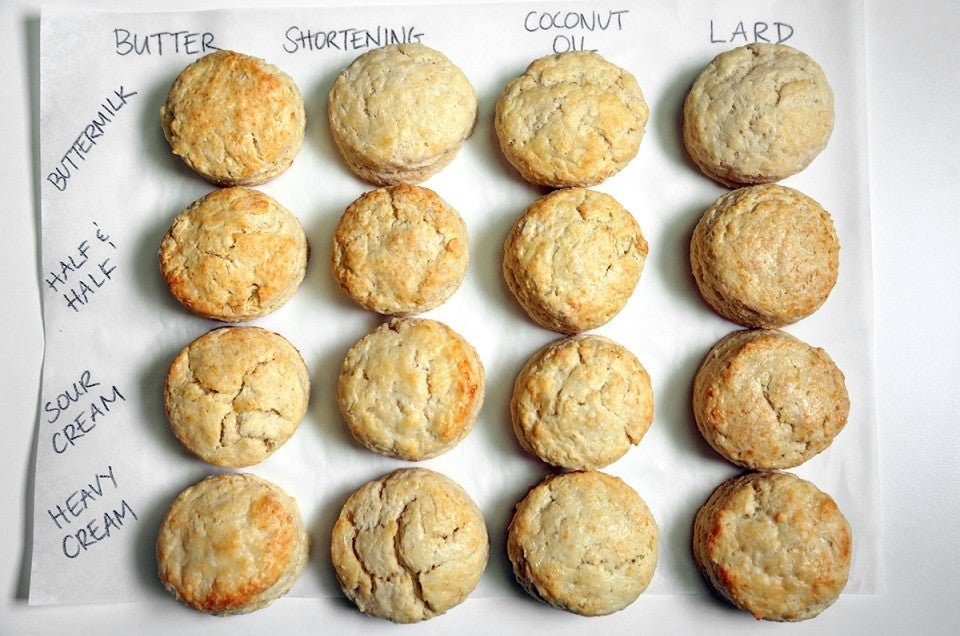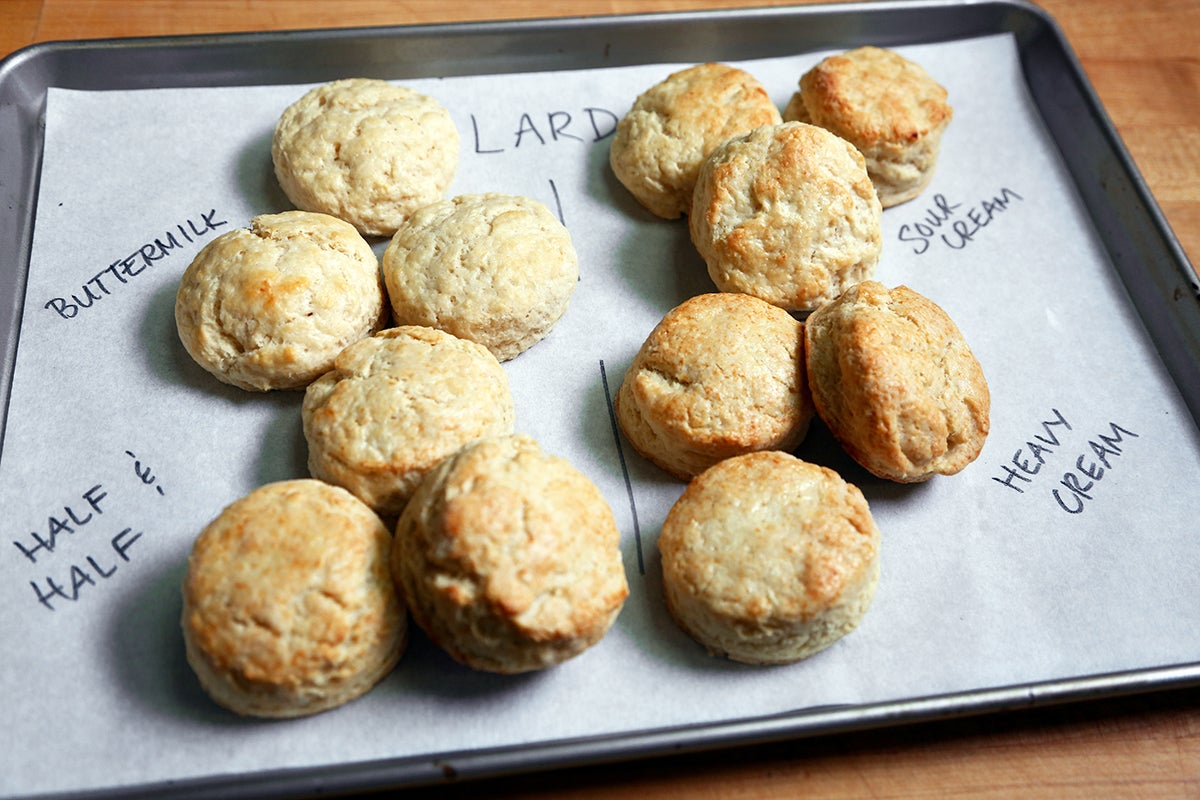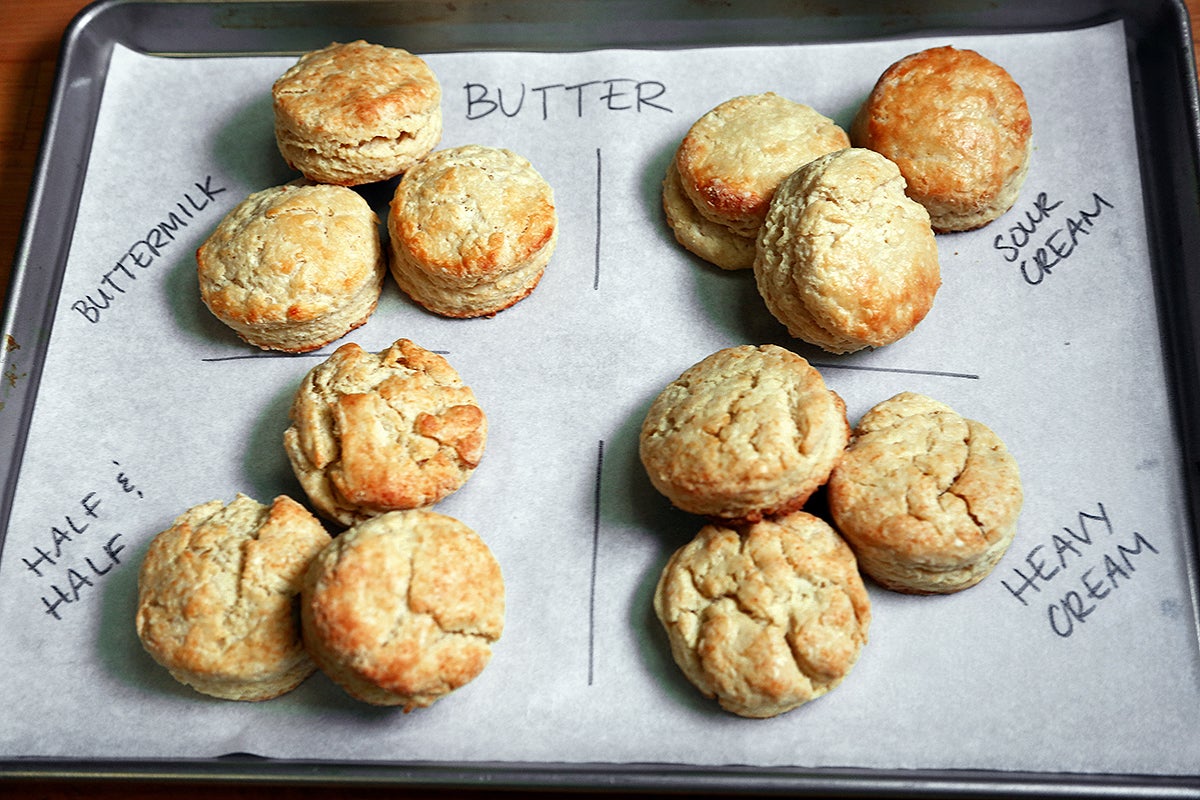


How do you like your biscuits? Tall and tender, with a golden-brown bottom? Or do you like them a bit flatter and more sturdy, so you can toast and slather them with jam? As the baker, you get to decide how to adjust the fats and liquids in biscuits so they have just the right texture and taste.
When you start with a foolproof recipe like our Buttermilk Biscuits, it’s easy to customize the final result. While it’s certainly important to follow recipes closely while baking, you have some flexibility when it comes to choosing certain ingredients.

Let's start with the base of any good biscuit — the fat. Our original recipe calls for 4 to 6 tablespoons of butter or shortening. The higher amount will give you a richer, more buttery crumb. I decide to split the difference for testing purposes and use 5 tablespoons (2 1/2 ounces).
Whenever we talk about fats in baking, we always hear from a portion of “lard-core bakers” (people who are dedicated to using lard). Customer feedback is something we take seriously here at King Arthur Flour, so we'll incorporate lard (as well as coconut oil) into our fat testing.

The butter version rises the highest — look at those flaky layers! The shortening biscuit is slightly shorter and a bit drier, too. Butter contains a bit of water, which helps create steam and gives baked goods a boost. (We discovered this to be true in our other explorations of butter vs. shortening, as well.)
The coconut oil biscuits are even shorter than the shortening biscuits, and the lard version is the squattest. Neither the coconut nor lard variations win the beauty contest, either. They're a bit soft looking and don't have that desirable, craggy exterior that makes biscuits so appealing.

In addition to rising the highest, the butter version is also the brownest.
Why? Butter contains milk solids, which include sugars that caramelize at high temperatures. Shortening, coconut oil, and lard are all 100% fat. They contain no milk solids or sugars, so they don't caramelize in the same way. Still tasty, just less golden brown.
This preliminary finding of what adjusting fat in biscuits can do is exciting, but it's also just the beginning. On to liquids!

Just as important as the fat is the liquid used to make your biscuits. Our Buttermilk Biscuit recipe offers the choice of using milk or buttermilk. Buttermilk is known for making biscuits tender and adding a zippy tang, so we used that for this test.
Choices are important in baking, so we'll also test variations with full-fat sour cream, half & half, and heavy cream. (You can also use plain, full-fat Greek yogurt in place of sour cream if you like.)
Each liquid has a different amount of water, fat, milk solids, and acidity — all of which can change the flavor and texture of your biscuits.
To see the effects of each liquid, we make a batch of all-butter biscuits and change only the liquid —testing buttermilk, sour cream, heavy cream, and half & half. (We leave milk out of these tests since milk and half & half should yield very similar results, with the half & half biscuits just slightly more tender).

It’s surprising what changing just one ingredient can do! The heavy cream biscuit is slightly paler than the other three, while the half & half version is the evenly brown. The buttermilk and sour cream versions are somewhere in the middle in terms of color: nicely caramelized around the edges.

You might be wondering, well, what about the height? Surprisingly, all four biscuits are about the same height, with the buttermilk version just a smidge taller than the rest. Turns out that fat affects the height and flakiness of biscuits, while liquid impacts the color more noticeably.
Now we have a basic idea of what to expect when adjusting the fat and liquid in biscuits. Time to personalize your biscuits and choose your favorite combination!

There's a bit of a baking frenzy in the test kitchen as I try out all the possible combinations of fat and liquid in biscuits. Here's what we find:

Shortening: A bit less flaky than some of the other versions but very tender — especially the heavy cream version: think melt-in-your-mouth texture. None of these has stand-out flavor though; they're a bit bland. Still, not bad overall.
Coconut oil: Slightly sweet flavor (though not coconut-y), most similar to butter in flavor. The texture of some of the higher-fat versions (heavy cream and sour cream) is a bit chewy/gummy. The best combination from this batch is coconut oil and buttermilk: delicate crumb and creamy flavor.

Lard: Savory aroma with a distinct taste (and aftertaste). In full disclosure, I'm a vegetarian so some trustworthy employee-owners taste this batch. They think these biscuits might be nice with a sauce (gravy) or spread. The lard and half & half version seem to be the favorite here.
Since lard is such a rich ingredient on its own, it might be good to combine it with another fat, like butter, to balance flavor.

Butter: Slightly sweet, caramelized flavor; nicely browned exterior. All the liquid combinations produce fluffy, springy texture with an impressive rise. The butter and heavy cream version makes a quintessential biscuit, suitable for all occasions.
But the one I can't get enough of? Butter and buttermilk biscuits. They're delightful in all ways you'd expect a biscuit to be, and a little lighter than their heavy cream counterpart. Butter/buttermilk biscuits are flaky, creamy, and downright comforting.

Just because my taste buds prefer a classic butter and buttermilk biscuit doesn't mean yours will, too.
Don't be afraid to adjust the fats and liquids in biscuits the next time you're called into the kitchen to whip up a batch.

Gluten-free bakers, feel empowered to experiment, too. Use our Gluten-Free Measure for Measure Flour to replace the all-purpose flour in our Buttermilk Biscuit recipe. Adjust the fats and liquids until you find the perfect balance of flavor and texture.
You might be surprised to find what your favorite combination turns out to be. Once you experiment with the fats and liquids in biscuits, let us know which you like best in comments, below.
Thanks to fellow employee-owner Seann Cram for taking the photographs for this post.

